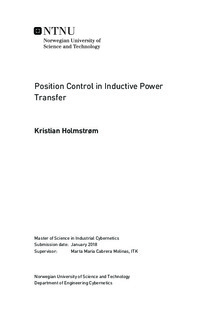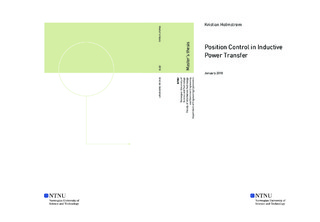| dc.description.abstract | The objective of this thesis has been to investigate the use of position control in inductive power transfer and how it compares to the state-of-the-art methods for inductive power transfer control.
In this thesis we have:
- Outlined the basic principles for the design and control of IPT systems for high power applications
- Calculated magnetic field for a thin circular coil and mutual inductance between two thin circular coils
- Calculated transfer functions for SS compensated IPT systems for CR and CV load
- Demonstrated position control for lateral and axial displacement of the receiving coil relative to the transmitter
The use of position control to keep the mutual inductance constant and thus optimize the efficiency of an IPT system has been investigated. With operations in the nearfield region, the mutual inductance is highly volatile, both for axial and lateral movement. Maintaining a constant reference position in this region imposes demanding requirements on both the controlling unit and the mechanical apparatus responsible for the physical movement. The farfield operation, however, is more forgiving.
Complete system analysis has to be done for each specific implementation, as the inertia of the system and the input dynamics must be known. The added cost of implementing and maintaining such a system needs to be considered. It is argued that for most high power applications, the state-of-the art solution is better for most high power applications. Tight position control may still have its niche applications.
Future work in this field, need to consider a specific application in order to get reliable information regarding the most important parameters: position measurements, actuators and life-cycle costs. Another line of future work is to continue the work of modelling the mutual inductance for general relative movement and try to find approximative solutions that can be used for simpler design of new systems. | |

